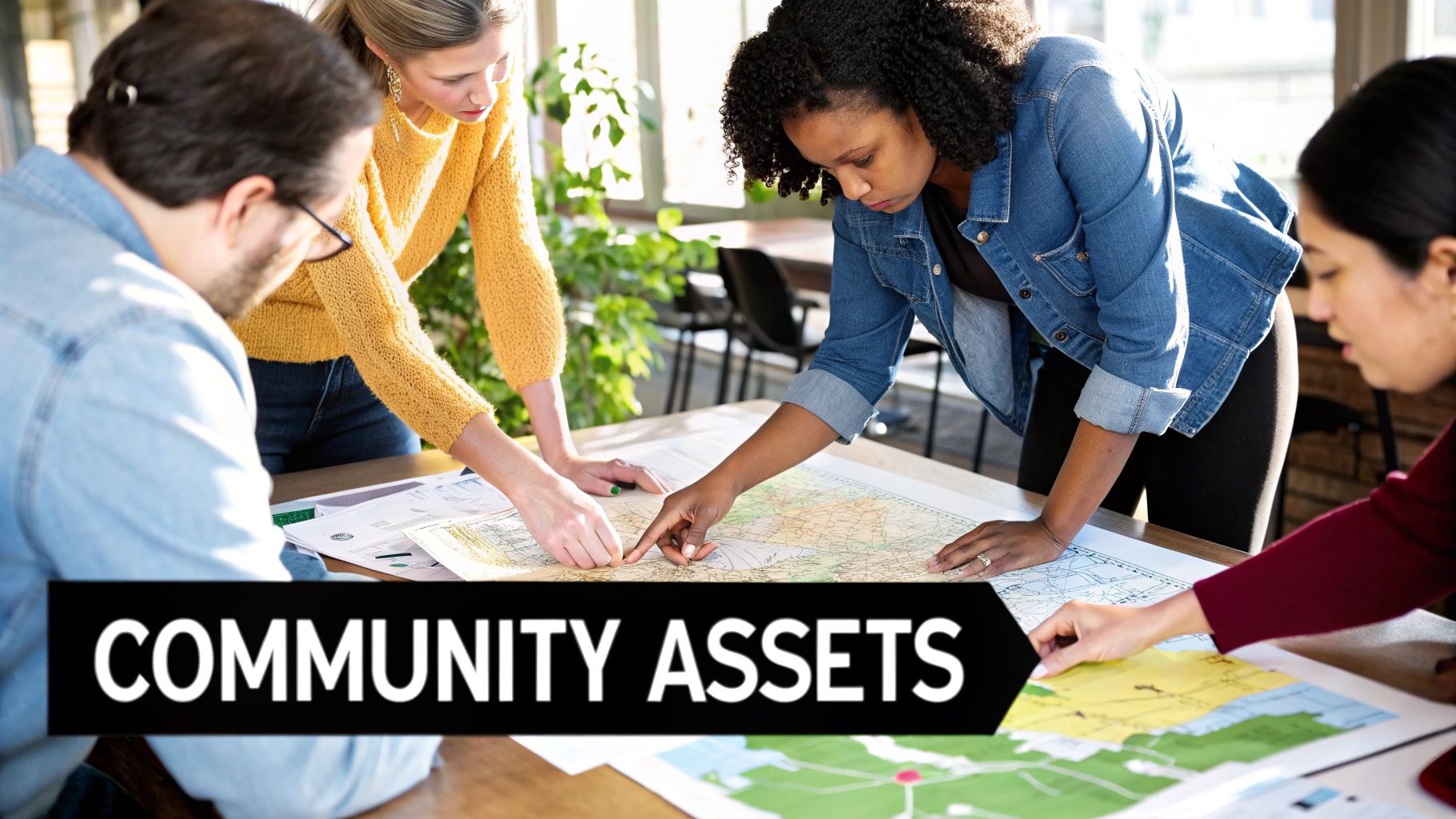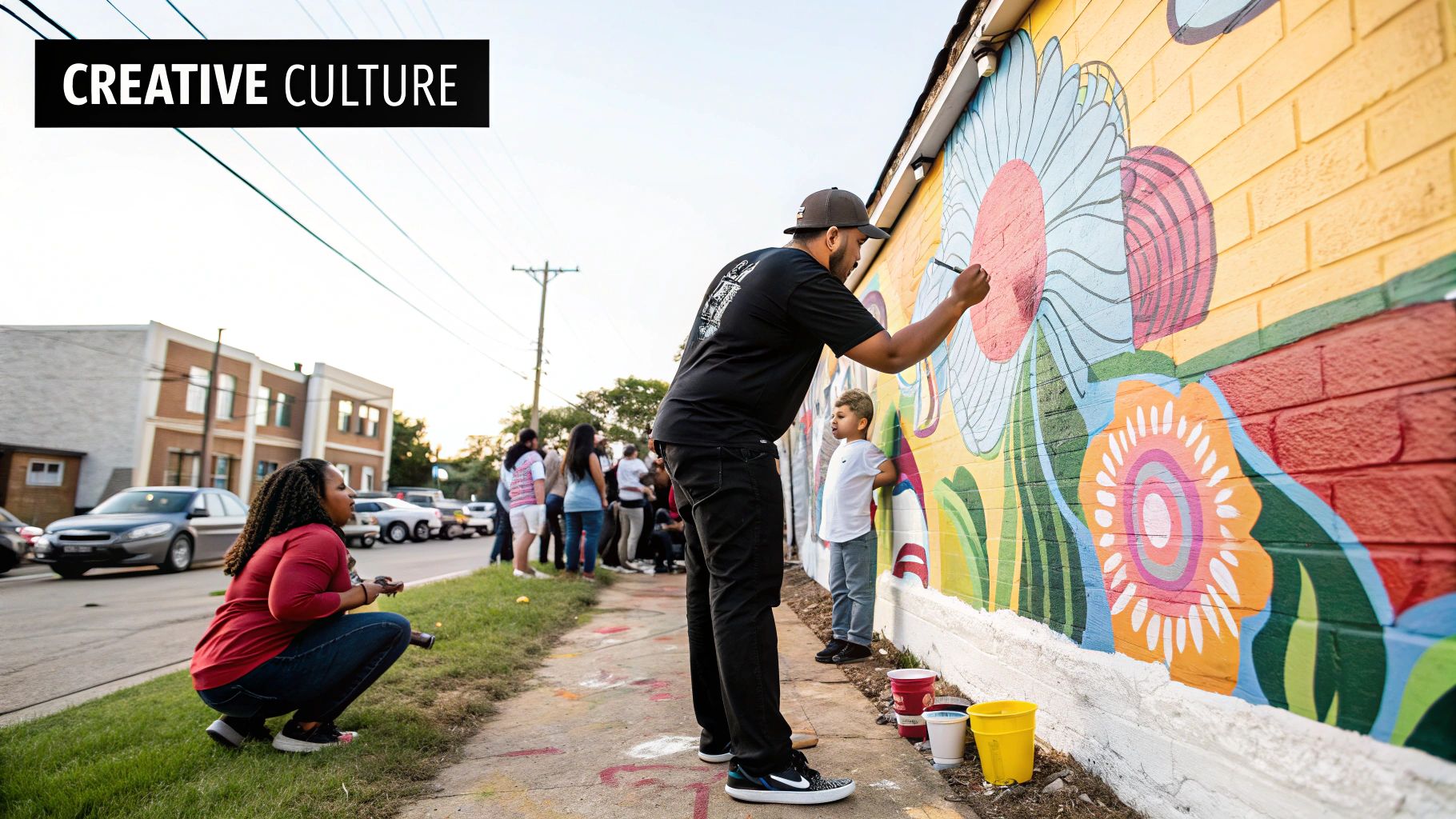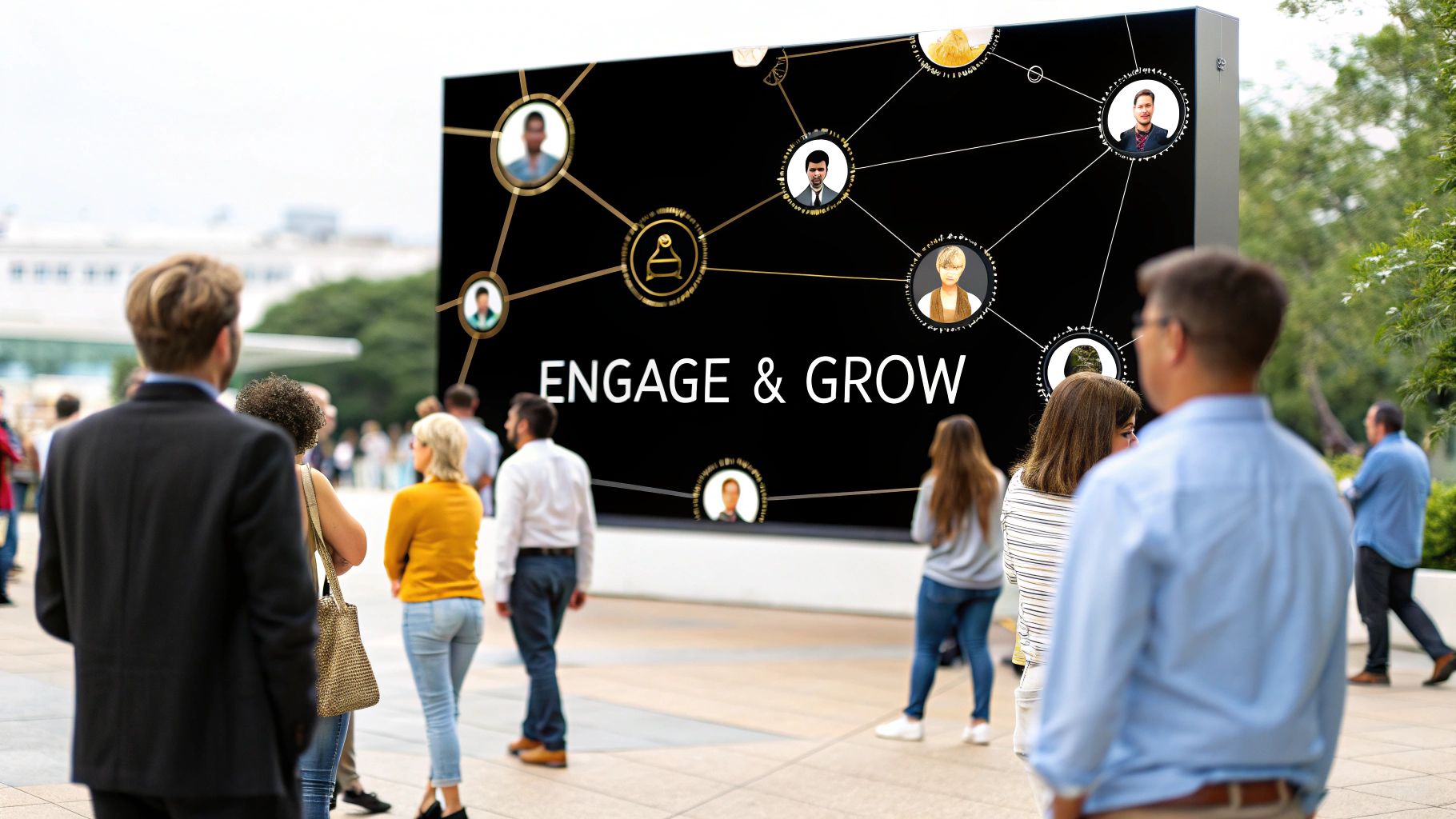In the competitive SaaS landscape, a great product is just the starting point. Sustainable growth hinges on building a loyal, active, and vocal user base—a true community. But how do you transform passive users into passionate advocates? The answer lies in effective community engagement strategies. These are not just feel-good initiatives; they are powerful growth engines that reduce churn, generate invaluable feedback, and create powerful social proof.
This article moves beyond generic advice to provide a deep dive into ten proven, actionable strategies, tailored for the unique dynamics of a SaaS business. We will explore methods like Asset-Based Community Development and Participatory Budgeting, offering practical implementation steps and specific tips to help you build a community that not only uses your product but actively helps it grow. To further explore how to cultivate vibrant online communities, you might consider insights on 10 customer engagement best practices that apply across various digital landscapes.
Get ready to learn how to strategically engage your users and unlock a new level of customer loyalty and organic growth. By the end of this guide, you'll have a clear playbook for fostering a thriving ecosystem around your software.
1. Asset-Based Community Development (ABCD)
Asset-Based Community Development (ABCD) is a powerful community engagement strategy that flips the traditional needs-based model on its head. Instead of focusing on problems and deficits, ABCD identifies and mobilizes the existing, often untapped, assets within your user community. This includes the skills, knowledge, talents, and resources of your members, creating a more sustainable and user-driven ecosystem.
This approach empowers your SaaS community to take ownership. It shifts the dynamic from your company "providing" value to the community "co-creating" value. This framework is particularly effective for building a resilient, self-sustaining community where members feel seen, valued, and essential to the platform’s success. It’s about building with your users, not just for them.

How to Implement ABCD in Your SaaS Community
To apply this strategy, start with an "asset mapping" initiative. This isn't just a survey; it’s an interactive discovery process.
- Map Individual Skills: Identify the unique talents of your users. Are some members expert content creators, skilled coders, or natural mentors? Platforms like Notion have seen success by identifying and empowering "Ambassadors" who are already experts in using their product.
- Identify Internal Resources: Discover what resources your users can share. This could be anything from custom templates and workflow guides to code snippets or integration advice.
- Connect the Dots: Create a platform or a dedicated space (like a forum channel or a user-generated library) where these assets can be shared. This connects users who have a need with those who have a solution, fostering organic collaboration.
This approach builds social capital and strengthens user-to-user relationships, making your community-and by extension, your product-stickier and more valuable.
2. Participatory Budgeting
Participatory Budgeting is a democratic community engagement strategy where community members directly decide how to spend part of a public or organizational budget. This process transfers decision-making power to your users, allowing them to propose, discuss, and vote on projects that matter most to them. It builds unparalleled trust and demonstrates a genuine commitment to user-centric development.
This approach transforms users from passive consumers into active stakeholders with a real financial stake in the community's future. For a SaaS platform, this could involve allocating a portion of a community development fund or a product feature budget. It ensures that resources are invested in initiatives that provide the most value to the people the platform serves, fostering deep loyalty and a powerful sense of ownership.

How to Implement Participatory Budgeting in Your SaaS Community
While pioneered in cities like Porto Alegre, Brazil, this model is highly adaptable for digital communities. You can allocate a budget for community-led feature enhancements, content creation, or events.
- Define the Scope: Clearly establish the budget amount and the types of projects eligible for funding. For instance, a portion of your marketing budget could be dedicated to community-led content initiatives or tutorials.
- Facilitate Idea Generation: Create a dedicated space for users to submit and discuss project proposals. This could be a forum category, a specific channel in your community platform, or a dedicated submission portal.
- Structure the Vote: Implement a transparent and fair voting process to allow members to select the winning projects. Celebrate the funded initiatives and provide regular updates on their progress to close the feedback loop and build momentum for future cycles.
This strategy not only surfaces the most desired improvements but also educates users on the trade-offs involved in product development and resource allocation, making them more empathetic and engaged partners.
3. Community Organizing and Coalition Building
Community Organizing and Coalition Building is a strategic approach that unites groups of users around a shared interest to drive collective action. Unlike other community engagement strategies that focus on content or support, this method is about building power. It involves identifying common goals, developing user leaders, and creating a unified front to advocate for significant product changes or platform improvements.
This framework is ideal when your SaaS needs to tackle large, complex challenges that require substantial user buy-in or a change in company direction. It transforms passive users into active stakeholders who can effectively lobby for their collective needs, ensuring the platform evolves in a way that genuinely serves its most dedicated members. This strategy is about mobilizing your community to create change from the ground up.

How to Implement Community Organizing in Your SaaS Community
This approach requires deep investment in relationships before taking any action. The goal is to build a strong, cohesive base that can act in unison.
- Identify Shared Interests: Begin by listening. What are the common frustrations or big-picture feature requests that unite a significant portion of your users? This is the foundation for your coalition.
- Develop User Leadership: Identify and empower natural leaders within these interest groups. Provide them with the tools, information, and a direct line of communication to your team to represent their cohort effectively.
- Build a Coalition for Action: Create a formal or informal council of these user leaders. For example, a "Product Advisory Coalition" could be formed to advocate for a major new integration or a change to the pricing model, giving them a real seat at the table.
By organizing users, you create a powerful feedback loop. It ensures that the loudest voices aren't the only ones heard, leading to more equitable and impactful product development.
4. Digital Community Platforms and Social Media Engagement
Leveraging dedicated digital platforms and social media is a cornerstone of modern community engagement strategies. This approach involves creating and nurturing virtual spaces where your users can interact, share information, and collaborate. By meeting users where they already are, you can build a vibrant, accessible hub for continuous communication and value exchange.
This strategy extends your brand's reach beyond your product’s interface, creating a persistent, dynamic connection with your audience. It transforms passive users into active participants by giving them a direct line to your team and, more importantly, to each other. Platforms like Slack, Discord, and dedicated forum software are ideal for fostering these deep, topic-focused interactions that build a strong sense of belonging and loyalty.

How to Implement Digital Platforms in Your SaaS Community
Successfully launching a digital community space requires a thoughtful, user-centric approach. The goal is to facilitate, not force, interaction.
- Choose the Right Platform: Go where your users are. Developers might prefer Discord or a dedicated Slack workspace, while a creative audience may thrive in a visual platform like a Facebook Group. Zapier effectively uses a dedicated community forum to allow users to share automation recipes and troubleshoot together.
- Create a Content and Engagement Calendar: Consistency is key. Plan regular content like Q&A sessions with product managers, weekly tips, or user-led "show and tell" events to keep the space active and valuable.
- Empower User-Generated Content (UGC): Encourage and celebrate when users share their own creations, stories, or solutions. Figma’s Community is a prime example, allowing designers to share templates and plugins, turning the platform into an indispensable, user-powered resource.
This method ensures your community is not just a support channel but a strategic asset that drives product adoption, gathers feedback, and fosters powerful brand advocacy.
5. Place-Based Community Development
Place-Based Community Development is a highly focused community engagement strategy that concentrates resources on improving a specific geographic area. Unlike broader approaches, this method tackles interconnected challenges such as housing, education, and economic opportunity simultaneously within a defined neighborhood or region, aiming for deep, long-term transformation.
This holistic framework is built on the understanding that community health is a product of many interrelated factors. For SaaS companies with a significant user concentration in a particular city or for platforms focused on local economies, this strategy offers a way to generate immense goodwill and tangible impact. It involves moving beyond digital-only engagement to invest directly in the physical communities where users live and work.
How to Implement Place-Based Development in Your SaaS Community
Implementing this strategy requires a long-term commitment and deep collaboration with local partners. It's about becoming part of a neighborhood's fabric.
- Establish Clear Geographic Boundaries: Define the specific neighborhood or district your initiative will serve. This focus is critical for concentrating resources and measuring impact effectively. The Harlem Children's Zone, for example, famously focuses its comprehensive services within a specific 97-block area in New York City.
- Invest in Comprehensive Data: Before acting, collect baseline data on key community indicators like employment rates, educational outcomes, and access to services. This data will guide your strategy and help you demonstrate progress over time.
- Create Formal Governance Structures: Build a leadership team that includes significant representation from community residents and local organizations. This ensures the initiatives are community-led and address authentic needs, a core principle of the Purpose Built Communities model.
This approach creates a powerful, localized brand legacy and demonstrates a profound commitment to your users' overall well-being, fostering unparalleled loyalty.
6. Cultural Arts and Creative Engagement
Cultural Arts and Creative Engagement is one of the more profound community engagement strategies, leveraging artistic expression to build connections and articulate a shared identity. Instead of relying solely on technical discussions or support forums, this method uses creative activities like storytelling, visual arts, and collaborative projects to unite users. It taps into the universal language of creativity to foster deeper, more emotional bonds.
This approach transforms a user base from passive consumers into active cultural participants. By providing platforms for creative expression, you empower users to tell their stories, share their perspectives, and shape the community’s identity. It’s a powerful way to build a vibrant, inclusive space where members feel a true sense of belonging and collective ownership, driven by shared creativity.
How to Implement Creative Engagement in Your SaaS Community
Start by integrating creative prompts and platforms directly into your community spaces. The goal is to make artistic expression an organic part of the user experience.
- Host Creative Challenges: Run contests for the best product-themed artwork, the most innovative workflow visualization, or the most creative use case story. Figma does this well by encouraging users to share designs and templates in its community hub, turning functional work into a form of creative expression.
- Launch a Storytelling Initiative: Dedicate a space for users to share their success stories. Much like the StoryCorps model, you can collect and feature user narratives about how your tool impacted their work or life, building a powerful repository of social proof and inspiration.
- Facilitate Collaborative Projects: Organize community-wide creative projects, such as building a collaborative resource library, designing a community mascot, or creating a shared "cookbook" of best practices.
This strategy humanizes your brand and fosters a community culture that values individual creativity and collective achievement, making your ecosystem more resilient and engaging.
7. Resident Leadership Development
Resident Leadership Development is a systematic approach to nurturing leaders from within your own user community. Instead of relying solely on internal staff to guide conversations and initiatives, this strategy identifies, trains, and empowers your most engaged members to take on formal leadership roles. This builds internal capacity, making your community more resilient, scalable, and authentically user-led.
This strategy ensures that your community's direction is driven by and accountable to the members themselves. It transforms passive users into active stakeholders who guide discussions, onboard new members, and organize events. This is one of the most powerful community engagement strategies for long-term sustainability, as it embeds leadership directly within the user base, creating a self-reinforcing cycle of engagement and ownership.
How to Implement Resident Leadership Development in Your SaaS Community
Start by identifying informal leaders already active in your community and create a structured pathway for them to grow.
- Create Tiered Leadership Roles: Offer opportunities at various commitment levels. This could range from "Forum Moderator" or "New Member Greeter" to more involved roles like "Chapter Lead" or "Product Advisory Council Member."
- Provide Training and Resources: Don't just grant a title; equip your leaders for success. Offer training on moderation, facilitation, and product expertise. Provide stipends or product credits to honor their time and contribution.
- Build a Peer Support Network: Create a private channel or group exclusively for your community leaders. This space allows them to connect, share best practices, and support one another, fostering a strong sense of camaraderie and shared purpose. A great example is how various Community Health Worker programs train local residents to become health advocates and leaders in their own neighborhoods.
8. Community-Based Participatory Research (CBPR)
Community-Based Participatory Research (CBPR) is a collaborative approach that positions community members as equal partners in the research process. Instead of your company studying your users, you work with them to identify key issues, design studies, gather insights, and co-develop solutions. This method fuses rigorous research with community organizing to drive meaningful product and platform improvements.
This strategy builds profound trust and ensures your product development roadmap is directly aligned with genuine user priorities. By involving users in the discovery and validation phases, you treat them as co-creators, not just data points. CBPR is one of the most powerful community engagement strategies for uncovering deep, contextual user needs that traditional surveys or analytics might miss, leading to more impactful and user-centric innovations.
How to Implement CBPR in Your SaaS Community
Implementing CBPR requires a genuine commitment to partnership and shared power. It goes beyond simple feedback collection and moves into co-ownership of the research journey.
- Build a Research Coalition: Form a steering committee of dedicated users who represent different segments of your community. Compensate them fairly for their time and expertise. This group will help shape research questions and methodologies.
- Provide Research Training: Equip your community partners with the skills they need to participate fully. This could include training on interview techniques, data analysis, or how to articulate findings effectively, empowering them as capable researchers.
- Translate Insights into Action: The research must lead to tangible outcomes. Work with your community coalition to prioritize findings and develop an action plan. For a SaaS platform, this could mean co-designing a new feature or overhauling a confusing workflow identified during the research.
This approach not only yields richer, more accurate insights but also fosters a group of highly engaged super-users who are deeply invested in your product's long-term success.
9. Collective Impact Framework
The Collective Impact Framework is a disciplined approach to collaboration that unites different organizations from various sectors around a common agenda. While often used for complex social problems, this model offers a powerful structure for SaaS companies looking to build a multi-faceted ecosystem that drives industry-wide change or solves a large-scale user problem. It formalizes collaboration beyond simple partnerships.
This framework is one of the more advanced community engagement strategies, ideal for when your SaaS product sits at the center of a diverse ecosystem of users, partners, and other stakeholders. It requires a significant commitment to coordination, including shared goals, consistent measurement, and continuous communication, often facilitated by a central "backbone" organization, which could be your company’s community team.
How to Implement the Collective Impact Framework in Your SaaS Community
Implementing this requires a long-term vision and significant investment in building and maintaining relationships.
- Establish a Common Agenda: Bring together key user groups, integration partners, and industry leaders to define a single, ambitious goal. For an analytics SaaS, this might be to "establish a new industry standard for data privacy."
- Create Shared Measurement Systems: Agree on the key metrics that will track progress toward the common agenda. All partners must collect and report data consistently to ensure alignment and accountability.
- Coordinate Mutually Reinforcing Activities: Each partner should undertake specific activities that support the overall goal. One partner might develop educational content, another might build a key integration, while your team hosts community events, all reinforcing the central mission.
- Invest in a Backbone Organization: Your community team must act as the facilitator. This involves organizing meetings, managing communications, mobilizing funding or resources, and analyzing data to keep the entire initiative on track.
10. Civic Technology and Smart City Engagement
Civic Technology and Smart City Engagement leverage digital tools to enhance communication and collaboration between a community and its governing bodies. This strategy involves using technology platforms specifically designed to improve government transparency, streamline service requests, and facilitate community problem-solving. This modernizes traditional civic processes, making it easier for members to participate in local governance and see tangible results from their input.
This approach is about creating more accessible, responsive, and data-informed communities. It transforms passive residents into active participants by providing clear channels for communication and feedback. For organizations or SaaS companies operating in the civic space, these tools are essential for demonstrating transparency and fostering a deep sense of shared ownership and progress. It’s a powerful method for building trust and proving that community voices directly influence decision-making.
How to Implement Civic Technology in Your Community
Deploying these tools requires a focus on accessibility and creating clear feedback loops to show that user input matters.
- Implement Issue Reporting Systems: Use platforms similar to municipal 311 systems where members can report issues, track progress, and see resolutions. This creates a direct line for service requests and accountability.
- Facilitate Participatory Governance: Employ platforms like Decidim or Consul to allow community members to propose ideas, deliberate on policies, and vote on community projects. This gives them a direct stake in the community's future.
- Visualize Community Data: Utilize tools like MySidewalk to present complex community data through interactive maps and dashboards. This helps members understand trends and make informed arguments, turning abstract data into compelling stories for change.
By integrating these technologies, you make participation more convenient and transparent, turning civic duty from a chore into a seamless and impactful part of community life.
Community Engagement Strategies Comparison Matrix
| Approach | Implementation Complexity 🔄 | Resource Requirements ⚡ | Expected Outcomes 📊 | Ideal Use Cases 💡 | Key Advantages ⭐ |
|---|---|---|---|---|---|
| Asset-Based Community Development (ABCD) | Medium - requires community organizing and asset mapping | Low to Medium - uses existing assets | Long-term community capacity, ownership, social cohesion | Communities leveraging internal resources for development | Sustainable, cost-effective, strengthens networks |
| Participatory Budgeting | High - complex democratic process | High - staff, facilitation, resources | Increased civic engagement, transparent budget use | Municipal budget allocation, democratic spending priorities | Enhances political participation, transparency |
| Community Organizing & Coalition Building | High - sustained organizing, advocacy | High - skilled organizers, time | Concrete policy change, community power building | Advocacy, systemic change, leadership development | Develops leadership, tackles root causes, builds power |
| Digital Community Platforms & Social Media | Medium - ongoing content, moderation | Low to Medium - digital tools and staff | Broad reach, rapid communication | Online community building, youth engagement | 24/7 engagement, cost-effective mass communication |
| Place-Based Community Development | Very High - multi-sector coordination, long-term | Very High - funding, coordination | Measurable neighborhood change, integrated improvements | Geographic, multi-issue neighborhood revitalization | Synergizes interventions, strong local ownership |
| Cultural Arts & Creative Engagement | Medium - event/program coordination | Medium - artist partnerships, funding | Diverse participation, cultural pride, social connection | Community identity, storytelling, social change through arts | Builds bridges, attracts diverse groups |
| Resident Leadership Development | Medium - training, mentoring systems | Medium - training and support | Strong resident-led initiatives, leadership pipeline | Capacity building for sustained community leadership | Authentic representation, sustainable capacity |
| Community-Based Participatory Research (CBPR) | High - research design and partnerships | High - training, time, trust-building | Relevant, actionable research, evidence for advocacy | Collaborative research addressing local priorities | Builds capacity, culturally appropriate, trusted data |
| Collective Impact Framework | Very High - coordinating many partners | Very High - coordination, backbone support | Multi-organization impact, shared accountability | Complex social problems needing cross-sector collaboration | Efficient resource use, sustainable collaborative infrastructure |
| Civic Technology & Smart City Engagement | Medium to High - tech development, maintenance | Medium to High - tech infrastructure, updates | Improved transparency, real-time feedback | Digital civic engagement, government transparency | Enhances participation, data-driven decisions |
From Strategy to Action: Building Your Community Flywheel
We have journeyed through ten distinct and powerful community engagement strategies, from the grassroots principles of Asset-Based Community Development to the forward-thinking applications of Civic Technology. This diverse toolkit demonstrates that there is no single, one-size-fits-all approach to building a vibrant user base. The true power lies not in attempting to implement every strategy at once, but in thoughtfully selecting the methods that resonate most deeply with your SaaS product, your target audience, and your core business objectives.
The underlying principle connecting all these tactics is the transition from a transactional relationship with users to a collaborative partnership. Whether you are empowering resident leaders within your user base, co-creating solutions through Participatory Budgeting, or building coalitions around shared goals, you are fundamentally shifting the dynamic. You are moving from simply providing a service to fostering a sense of shared ownership and collective purpose. This is the essence of sustainable community building.
Turning Concepts into Tangible Results
The real challenge, and the greatest opportunity, lies in bridging the gap between planning and execution. The journey from outlining your community engagement strategy to actually seeing it in action requires a clear path, much like the process of turning vision into reality. Start small. Identify the single strategy that offers the most immediate value or feels most achievable for your team right now.
Consider these actionable next steps:
- Audit Your Community Assets: Before launching a new initiative, use the Asset-Based Community Development (ABCD) lens to identify the existing skills, passions, and leaders within your user base. Who are your power users? What are they already creating?
- Launch a Pilot Program: Test a concept like Community-Based Participatory Research (CBPR) with a small, dedicated group of users. Co-develop a research question about a specific product feature and work with them to find the answer.
- Map Your Stakeholders: If a Collective Impact Framework resonates with you, start by simply mapping the key players in your ecosystem. Identify potential partners, complementary tools, and influential voices who share your mission.
Igniting Your Community Flywheel
Mastering these community engagement strategies is about more than just boosting retention or improving user feedback. It is about creating a self-sustaining "community flywheel." An engaged community provides invaluable insights, which leads to a better product. A better product attracts and retains more users, who then become active and engaged community members, feeding more energy back into the cycle. This positive loop generates its own momentum, creating organic growth and an unparalleled competitive moat.
By investing in genuine engagement, you are not just building a user base; you are cultivating a legion of advocates, collaborators, and evangelists who are deeply invested in your success because it is intertwined with their own. This authentic connection is the most durable asset a modern SaaS company can build. Choose your starting point, commit to the process, and begin building the community that will not only use your product but champion it.
Ready to add high-octane fuel to your community flywheel? Refgrow makes it easy to embed a native affiliate and referral program directly into your SaaS application. Empower your most passionate community members to become your best marketers and reward them for spreading the word. Launch your referral program in minutes with Refgrow.

